In early October, Rachel Sussman felt catharsis as she sat among hundreds of people for the Broadway debut of Is This A Room at New York City’s Lyceum Theatre.
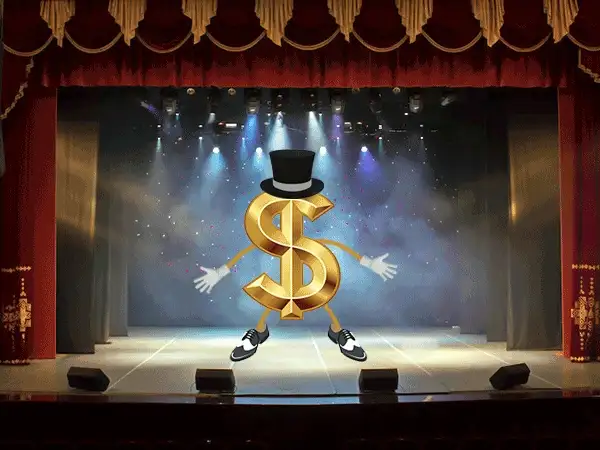
After the curtain fell, the backstage crew joined the actors to glow in the applause. The person who inspired the show, Reality Winner, beamed in from Zoom, connecting the drama of the stage to real life.
“Going back… helped me remember this is what it all leads up to, getting to a theater and feeling such pride at watching a really incredible piece of work in front of your eyes,” Sussman, a coproducer of the show with her company Plate Spinner Productions, told The Hustle.
Then, a few weeks later came some unfortunate news: Is This A Room, which had been lauded by critics, was closing early.
Crowds were still hesitant to return to recently reopened Broadway, and the producers and investors who spent $3.5m to bankroll Is This A Room and a sister play, Dana H., were not making enough.
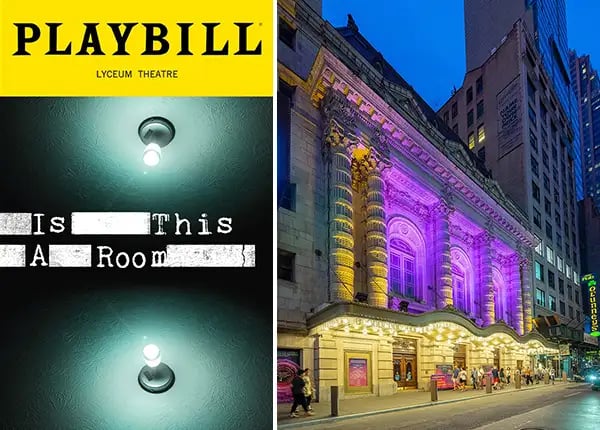
(via Playbill, Wikipedia)
It was evidence the pandemic has made a risky and complicated business even riskier and more complicated. Despite drawing 14m+ people a year — higher attendance than all NYC-area sporting teams combined — Broadway shows rarely have happy endings in the financial sense.
On Broadway, ~80% of producers and investors struggle to recoup their investments, a number that has stayed consistent since at least the 1960s. Almost everyone agrees tickets are too expensive, yet slashing prices would almost certainly lead to greater failures.
And even though megahits like The Lion King, which has grossed a Broadway record $1.7B, happen every few years, the formula for success remains elusive.
“There’s an old industry (saying),” said Sussman, who also co-owns the consulting firm Business of Broadway. “‘You can’t make a living, but you can make a killing.’”
So how do the economics of Broadway function?
To find out, The Hustle researched statistics dating back to the 1920s and spoke with several insiders about production, theater ownership, and the difficulty of predicting a hit.
The basics of Broadway
Broadway has nothing to do with the street cutting diagonally through the city: It is a designation codified in union contracts that encompasses all theaters with 500 or more seats in midtown Manhattan. (Off-Broadway shows are Manhattan-based and have between 100 and 499 seats; off-off Broadway have fewer than 100.)
In terms of revenue, Broadway was as healthy as ever before the pandemic struck, grossing $1.8B in the 2018-19 season, according to the Broadway League. Revenues have increased every year since the 1985-86 season, when shows made an inflation-adjusted $444m.
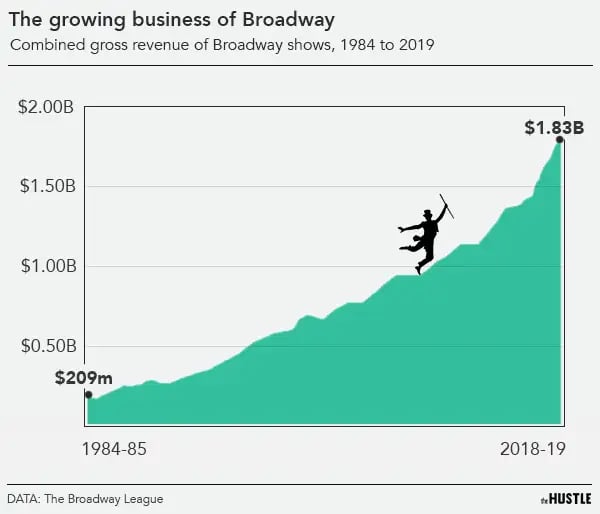
Zachary Crockett / The Hustle
There are a few reasons for this. Between 1984 and 2019:
- Attendance has increased from 6.5m (1984-85) to 14.7m
- Average ticket price has climbed from an inflation-adjusted $74 to $124
The dramatic rise in pricing is relatively new for Broadway.
Accounting for inflation, the average ticket for a musical was ~$66 in 1960. The increase has been driven by higher production budgets and higher salaries for staff but also from minor shows riding the momentum of the biggest hits.
Seasonal patterns and even day-to-day weather affect pricing, and Broadway producers in recent years have used algorithms to alter ticket prices on an hourly basis.
Producers who can’t sell out their shows offer tickets to the nonprofit TDF, which sells them at Times Square and Lincoln Center booths at a 20%-50% discount. According to Victoria Bailey, executive director of TDF, ~33% of people who use TKTS are seeing their first Broadway show.
But even the best efforts of groups like TDF to make Broadway more affordable and more democratic come up short.
The best seats will almost always cost at least $200 and sometimes more than $1k. The average income of Broadwaygoers in 2018-19 was $261k — roughly 4x the median household income in the US.
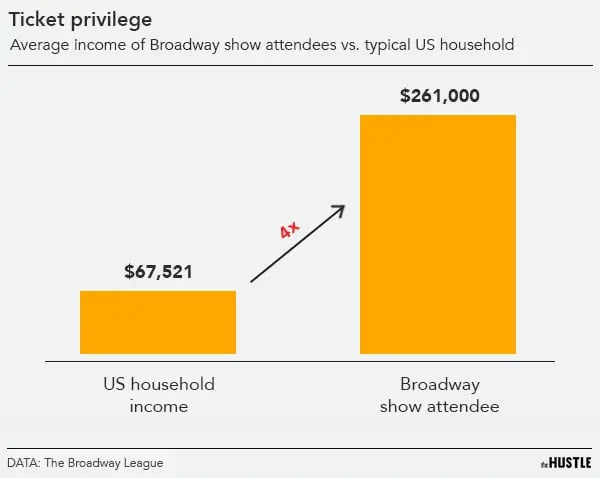
Zachary Crockett / The Hustle
Why are tickets so pricey? It’s the nature of live entertainment.
The shows are expensive to produce — and unlike movies, they can’t be scaled globally. Instead, they are performed 1-2x per day in theaters ranging in capacity from ~500 to ~1.7k, creating unusual supply and demand issues that affect both megahits and run-of-the-mill shows.
Hamilton, for instance, has been playing at the Richard Rodgers Theatre (capacity: 1.3k) since 2015. At its peak in 2016 and 2017, even with tickets priced at over $1k, there weren’t enough seats available to meet demand.
Lesser-known shows have the opposite problem. There aren’t enough people willing to pay $100 and up for a ticket, but the limited capacities and inability to scale mean producers can only sacrifice price so far in hopes of drawing crowds willing to pay less.
It all makes for a precarious situation for producers and investors.
How Broadway musicals get made
A Broadway show begins when somebody has a great idea. The next step is finding massive sums of money.
Producers typically get capital from investors in units of $25k to $50k, similar to shares of stock. Many investors are theater fans whose appreciation for the aura of Broadway outweighs the financial risk.
The upfront cost, known on Broadway as capitalization, is usually $3m-$5m for plays and $10m-$20m for musicals.
“If you need your head examined it can go up to $70m, as Spider-Man did,” John Breglio, a Broadway producer, entertainment lawyer, and author of I Wanna Be a Producer, told The Hustle.
And the production budget is just the beginning.
The expenses add up every time a show is performed, and these operating costs, ranging from marketing to equipment rentals, easily total $200k a week and often $500k+.
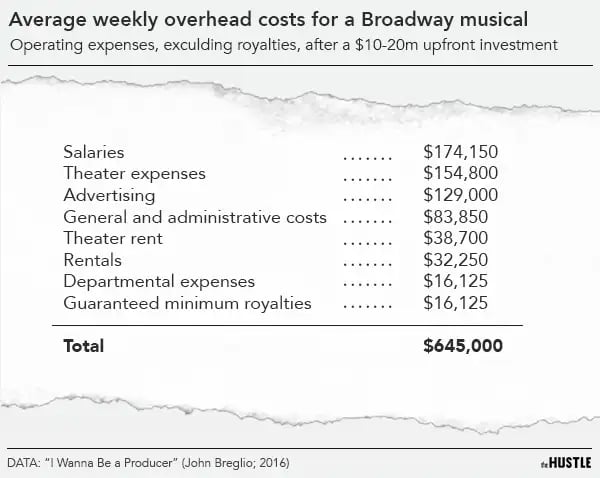
Zachary Crockett / The Hustle
The goal for every show is to sell enough tickets at a high enough price to exceed the operating costs.
Theater owners and producers usually set a stop clause slightly below the break-even total, and either party may cancel a show if its box office gross fails to reach the set amount for 2 consecutive weeks.
When shows do make money, the operating profits get funneled into a “royalty pool” to be divided among the creative team and investors, who usually get 65%.
When enough profit has been made to surpass the original production budget, the lead producers, who at first make just a small fixed fee and a slice of the creative team’s portion of the royalty pool, start receiving as much as 50% of the investors’ portion of the royalty pool.
Hamilton, which has a weekly operating budget of ~$643k excluding royalties and theater rent, covered its $12.5m production budget 6 months after its summer 2015 debut by pulling in ~$1.5m in revenue every week. In 2017, its weekly grosses topped $3m, the vast majority of it a windfall for the investors and producers.
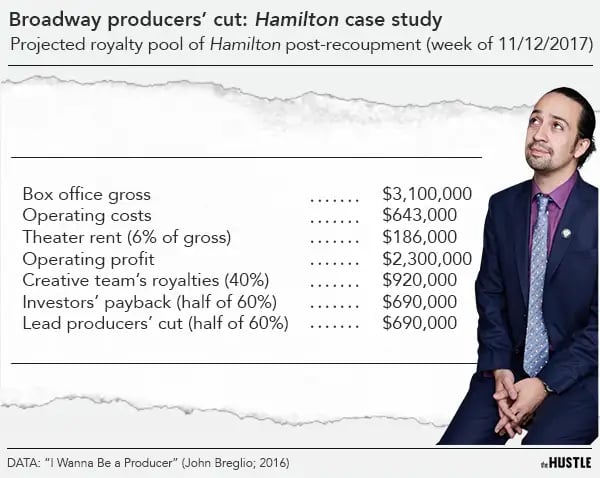
Zachary Crockett / The Hustle
Successful shows often have a couple of key characteristics: a well-known actor or actress and a familiar story, a la The Lion King and Aladdin.
But Spider-Man showed popular IP can backfire, and star actors typically sign up for just a few months, or even weeks, giving investors and producers a limited time to recoup their expenses.
Likewise, shows that lack both an established star and a familiar story can still strike it big.
“Hamilton is an example of really a black swan, just such an outlier,” Sussman said.
In short, nobody really knows whether something will be successful. But even when shows flop financially, one group on Broadway still makes money: the theater owners.
The theater owner monopoly
The best way to think of theater owners is as landlords.
They own a piece of property on which they owe taxes, utilities, and insurance (as well as some wages to staff) and rent it out to Broadway productions to cover their costs.
Owners charge the producers a weekly flat fee — usually $10k-$20k — that covers the owners’ entire costs, from property taxes and the mortgage to staff wages down to toilet paper.
On top of the fees, they take 5%-7% of the weekly box office gross. This money is pure profit and can easily top $100k for a hit show and even $25k for a struggling show.
Billboards on Broadway (Getty Images / animation by The Hustle)
Owners exert these terms because Broadway theaters are a limited commodity and a few ownership groups have near-monopolistic power.
- 3 companies — Jujamcyn Theaters, The Shubert Organization, and The Nederlander Organization — own 31 of the 41 theaters on Broadway.
- Long-running hits like The Lion King, Wicked, The Book of Mormon, and The Phantom of the Opera occupy several theaters. With only ~25 theaters up for grabs in a given season, producers will do almost anything to nab a spot.
“All we do is open the door in the morning, and there’s a line of suckers — well, I should say producers — begging to get in,” one theater owner told Variety in 2019. “This business has never been better.”
Of course, the pandemic changed everything in March 2020. The only time theaters struggle is when they lack tenants. And for 18 months they didn’t have any.
The future of Broadway
The day Broadway reopened, on September 14, Lin-Manuel Miranda, the creator of Hamilton, stood above a throng of theater fans on midtown Manhattan’s 46th Street and belted the chorus of “New York, New York.”
New York needs Broadway: The industry supports 97k jobs and contributes $14.7B in local economic impact.
And Broadway needs New York, specifically the New York that draws millions of visitors from around the world.
Some 65% of tickets are sold to tourists. If they don’t come back, Broadway could struggle for the foreseeable future, as it has for the first several weeks since it reopened.
Although the Broadway League has not released box office data this fall, Sussman and Breglio told The Hustle business has been rough.
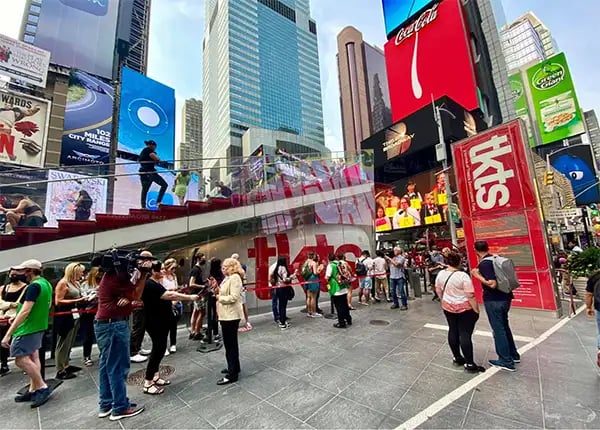
Theatergoers lined up for discounted tickets at the TKTS booth in Times Square the day Broadway reopened in September. (Via TDF)
But obituaries for Broadway have been written many times before: The introduction of sound to motion pictures and the Great Depression gutted the theater industry in the 1930s. In the 1970s, attendance lagged when Times Square and much of Midtown faltered under disinvestment.
Every time, Broadway bounced back.
The magic of a live show continues to draw people who want to perform, produce, or invest in them, economics be damned.
“Underneath all of this, there isn’t logic,” TDF executive director Victoria Bailey says. “There’s someone who has a project that they deeply believe in.”
